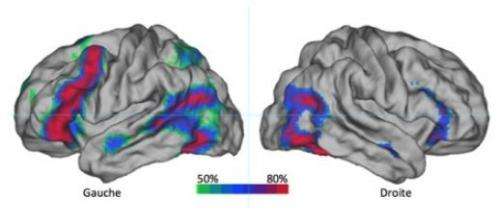A dominant hemisphere for handedness and language?

Through an innovative approach using a large psychometric and brain imaging database, researchers in the Groupe d'Imagerie Neurofonctionnelle (CNRS/CEA/Université de Bordeaux) have demonstrated that the location of language areas in the brain is independent of left- or right-handedness, except for a very small proportion of left-handed individuals whose right hemisphere is dominant for both manual work and language. This work was published in PLOS One on June 30, 2014.
Humans are the only species in which asymmetric motor behavior is preponderant: 90% of people prefer to use their right hand and 10% their left hand. This motor behavior is "cross-lateralized": when using the right hand, the dominant left hemisphere is activated. Along with motor behavior, language is one of the most lateralized functions of the human body: the networks of brain areas controlling language are located asymmetrically in the brain's left or right hemisphere. Many studies have shown that the left hemisphere is dominant for language in 90% of cases, as it is for motor behavior.
Are the 10% of people who are left-handed and of those whose language is located in the brain's right hemisphere the same? Is the location of language areas in the brain correlated to handedness? To answer these questions, researchers from the Groupe d'Imagerie Neurofonctionnelle recruited a large sample of participants (297) including numerous left-handed subjects (153). Whereas most other studies only relate to right-handers (a majority of the population) these researchers analyzed language lateralization for the first time in a large number of right- and left-handed individuals. The subjects in this sample were assessed using functional MRI while they performed language tests. Three types of language lateralization were then revealed from the images obtained (see figure 1): "typical" with a dominant left hemisphere (present in 88% of right-handers and 78% of left-handers), "ambilateral" without a clearly dominant hemisphere (present in 12% of right-handers and 15% of left-handers), and "strongly atypical" with a dominant right hemisphere (present only in 7% of left-handers). Statistical analysis of this distribution shows that concordance between the dominant hemisphere for handedness and that for language is random, except for a small fraction of the population (less than 1%) for whom the right hemisphere is dominant for both language and handedness.
These results show that knowing an individual's preferred handedness it is not sufficient to determine their dominant hemisphere for language. Researchers will now attempt to elucidate why only a small group of left-handers have a dominant right hemisphere for language, particularly by finding out whether there are genetic variants that might explain this phenomenon. These results also demonstrate that by contrast with a sample including a majority of right-handers, a sample enriched with left-handers composed from a large database shows variability factors in the brain structural and functional correlates: determining the sources of this variability in language lateralization may help to elucidate language pathologies.
More information: Gaussian mixture modeling of hemispheric lateralization for language in a large sample of healthy individuals balanced for handedness. Bernard Mazoyer, Laure Zago, Gaël Jobard, Fabrice Crivello, Marc Joliot, Guy Perchey, Emmanuel Mellet, Laurent Petit, Nathalie Tzourio-Mazoyer. PLOS One, June 30, 2014.
















